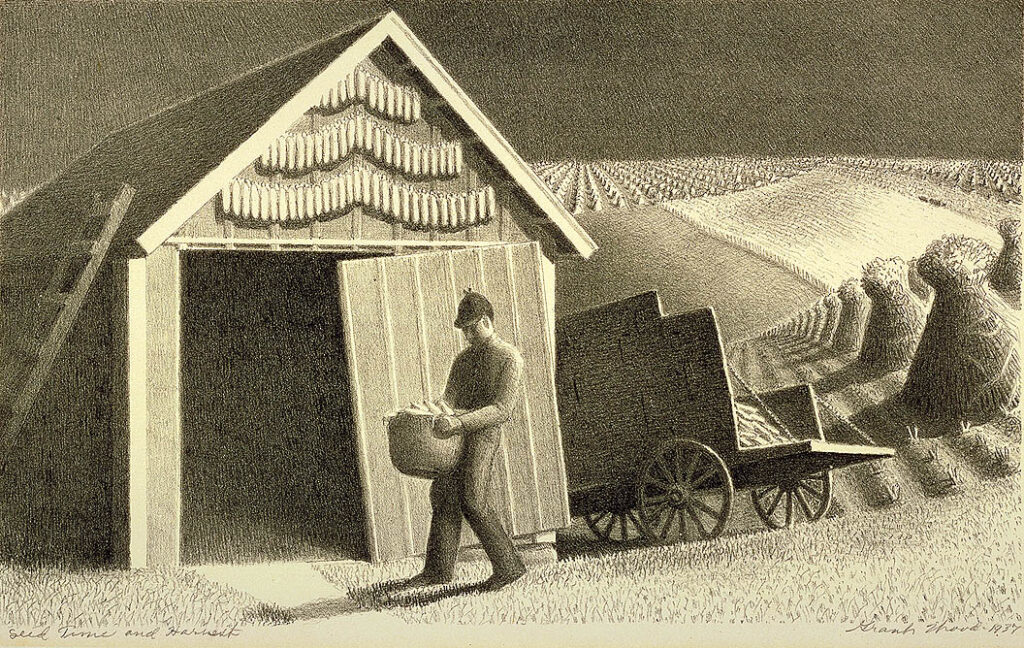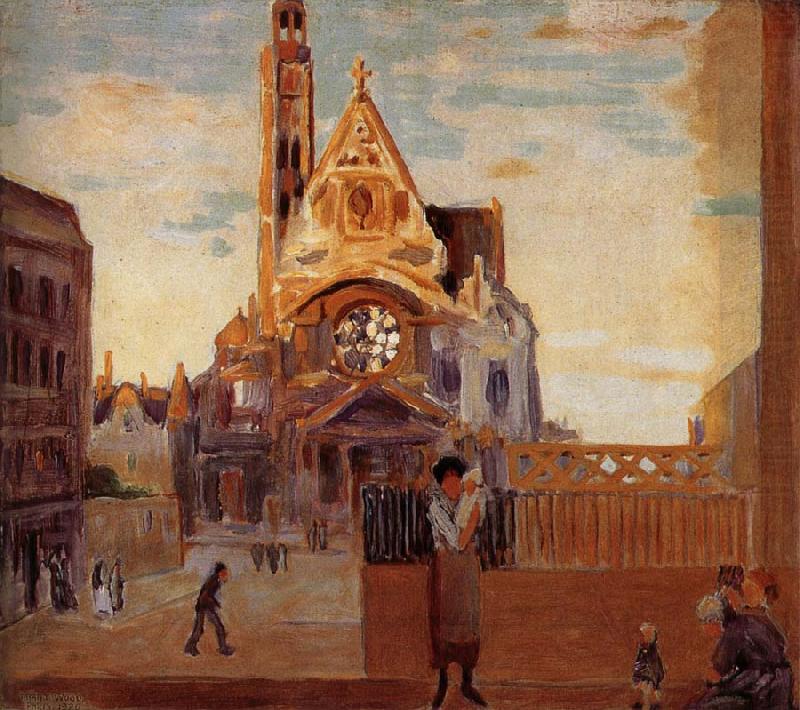The most well-known contribution Grant Wood made to American art in the 20th century was his vivid portrayals of the Midwest’s rural areas. Wood, born in rural Iowa in 1891, uses a combination of realism and romanticism to create visually striking narratives that encapsulate the essence of American life during the Great Depression. His paintings, distinguished by their rich colour and careful detail, show a critical eye and a profound respect for American nature and culture.
The 1930 painting “American Gothic,” perhaps Wood’s most famous piece, represents the tenacity and austerity of the American people. The severe countenances of the farmer and his daughter, juxtaposed against the background of a Gothic Revival mansion, have grown deeply embedded in the collective mind. Beyond “American Gothic,” Wood’s body of work consists of a wide range of landscapes, portraits, and everyday situations that, taken as a whole, provide a window into the spirit of America at a crucial moment in history.
Wood’s style, sometimes called regionalism, originated as a counter-movement to the cosmopolitan and abstract styles that ruled the art world during his era. His dedication to portraying the American Midwest with love and a critical eye solidified his reputation as a pivotal figure in the history of American art. This article explores Grant Wood’s paintings’ topics, techniques, and cultural significance and how his work still impacts audiences today.
Technique does not constitute art. Nor is it a vague, fuzzy romantic quality known as ‘beauty,’ remote from the realities of everyday life. It is the depth and intensity of an artist’s experience thatarethe first importance in art. -Grant Wood

Grant Wood/wiki
Grant Wood’s paintings are highly acclaimed for their distinct blend of social commentary, symbolism, and realism. Wood mainly utilised his paintings to remark on the injustice and immorality of America’s social and economic institutions, and his works regularly questioned the conventional American ideals of the period. He was especially critical of the abuse of the working class and the nation’s capitalist system. Wood frequently depicted the hardships of the ordinary person in his paintings, as shown in “American Gothic.” The difficulties faced by rural America during the Great Depression are depicted in this picture by a farmer and his daughter standing in front of a modest house.
Many people read the painting as a criticism of the stiff, stoic character of the farmer, his daughter, and small-town, rural values. Because the pair is portrayed as wearing outdated attire and the house is a holdover from bygone eras, it has also been read as a critique of the times.
Additionally, Wood frequently depicts the Midwest’s shifting terrain due to modernity and industrialization. His picture “The Midnight Ride of Paul Revere,” which features a horseman riding through the night against a backdrop of a contemporary cityscape, is a symbolic portrayal of the changes occurring in America at the time. Wood frequently incorporates social commentary into his paintings by examining how industrialization has affected rural America and how the times are changing. His writings serve as a helpful reminder of the worth of upholding traditional rural values and the necessity of being true to one’s heritage. In addition to attempting to offer a glimpse into the lives and ideals of rural Americans, Wood also aimed to highlight important social and political topics of the day through his works.
Grant Wood Paintings
The most well-known picture by Wood is American Gothic (1930), which shows a woman standing next to a stern-looking farmer brandishing a pitchfork in front of a home with a characteristic Gothic window. Dr. Byron McKeeby, Wood’s dentist, and his sister Nan Wood Graham served as the painting’s models. In the picture Arbour Day (1932), students and their instructor are depicted planting a tree in front of a one-room schoolhouse. It honours rural America’s principles of community and education.
The undulating terrain of Stone City, Iowa (1930), where Wood established an art colony, is depicted. The landscape depicted in the artwork is verdant, with winding roads and stone structures. Wood’s mother, Hattie Weaver Wood, clutches a potted plant in the portrait Woman with Plants (1929). The picture style is influenced by the Flemish Renaissance, which Wood found to be quite beautiful.
Young Corn (1931) is an idealised portrayal of the Midwest’s agricultural life, showing a softly undulating field with freshly sprouted corn. Three older women who are Daughters of the American Revolution are satirically portrayed in the 1932 film Daughters of Revolution. It displays Wood’s scepticism about some facets of American nationalism. In Wood’s inventive reenactment of Paul Revere’s well-known journey, The Midnight Journey of Paul Revere (1931). Revere is depicted in the painting galloping through a quiet, peaceful New England village at night. The geometric patterns made by ploughing fields are shown in Fall Ploughing (1931). It highlights the balance that exists between nature and agribusiness.

Grant Wood/wiki
The 1939 painting “Fruits” is a lesser-known but noteworthy work by Grant Wood. “Fruits” is a still life painting that demonstrates Wood’s versatility as an artist, in contrast to his more well-known pieces, which frequently centre on rural landscapes and portraiture. Various fruits, including pears, apples, grapes, and peaches, are placed aesthetically beautifully in the artwork. The fruits are portrayed with a great deal of realism and detail. “Fruits” is painted in the exacting, precise manner typical of Wood’s artwork. The meticulous rendering of the fruit textures showcases Wood’s technical proficiency.
Grant Wood’s powerful painting “Fertility” (1939) captures his fascination with themes of rural life and agricultural abundance and his strong bond with the Midwestern environment. “Fertility” shows a verdant, undulating terrain with well-groomed fields and many crops ready to harvest. Emphasising the land’s fertility, the artwork presents a plentiful, ideal vision of agricultural prosperity. The careful rendering of the bountiful fields and the general symmetry of the scene represent the land’s capacity for growth and provision of food. This is consistent with Wood’s overarching themes of appreciating rural life and the bond between humans and their surroundings.
Grant Wood finished painting “Family Doctor” in 1941. Though not as well-known as some of his other compositions, this piece is essential to his work. The painting’s heartfelt portrayal of a rural doctor performing a house call highlights the close-knit and individualised quality of medical care in small towns at that time. The picture depicts an old doctor ministering to a small, sick child in bed in a pleasant, well-lit chamber. The scenario features a worried mother watching the youngster and other small details that give the space a cosy, caring feel.
Among his collection of paintings, Grant Wood’s “The Pump” is a lesser-known yet noteworthy piece. Entired in 1932, “The Pump” perfectly captures Wood’s emphasis on rural American themes and meticulous attention to detail. A central pump, which is often seen in rural areas and is used to extract water, is depicted in the artwork. The pump is surrounded by a calm, finely drawn countryside that demonstrates Wood’s skill at portraying the spirit of the Midwest. The composition’s main feature is the pump, making it straightforward and impactful. Wood has rendered the surrounding details, which include trees, a house, and far-off fields, with his customary attention and accuracy. This picture perfectly shows his ability to see the beauty and meaning in commonplace rural scenery and items.
One of Grant Wood’s most well-known pieces, In the Spring (1939), showcases his distinctive Regionalist aesthetic and robust ties to the American Midwest. An early springtime rural area is depicted in the picture. The picture depicts a farmstead with a farmer standing in the middle, staring at the newly sprouting crops. The farmer seems to be thinking about the next season and the tasks. The scenery is verdant and beautiful, with undulating hills in the distance. The accurate depiction of the vegetation, the farmer’s clothing, and the textures of the surroundings all display Wood’s distinctively detailed approach. The picture combines realism and an almost idealized, slightly stylized portrayal of rural life.
“Seed Time and Harvest” is among the lesser-known yet important pieces by Grant Wood. As part of the Public Works of Art Project, this 1937 mural-sized painting was commissioned for the Iowa State College (now Iowa State University) in Ames, Iowa. Wood painted a more extensive sequence of murals for the institution, of which “Seed Time and Harvest” is a part. The artwork, which shows several farming processes from planting to harvest, honours agricultural techniques. It depicts the work and cycles of agriculture, capturing the spirit of rural American life. The artwork is divided into pieces representing various stages of farming operations. Its meticulous depiction of farm life, including images of planting, raising crops, and harvesting, makes it unique.
Grant Wood’s less well-known but essential painting “Approaching Storm” conveys the suspense and drama of an approaching meteorological event in the rural Midwest. The picture shows a rural scene with a foreboding sky. Fields and probably a farmstead can be seen in the foreground, while the horizon is dominated by black, whirling clouds that indicate an approaching storm.
Grant Wood’s paintings remain influential depictions of rural life and American identity. With his exacting attention to detail and precise craftsmanship, Wood transformed the ordinary into the spectacular, immortalising the Midwest and its inhabitants. His well-known pieces, such as “American Gothic” and “The Midnight Ride of Paul Revere,” never fail to enthral viewers and challenge us to consider the nuanced aspects of our shared American past. Wood conveyed a specific moment and the spirit of a country experiencing significant social and economic transformation with every brushstroke. His legacy reminds us of the art’s eternal ability to illuminate our experiences and spark ideas for future generations.






